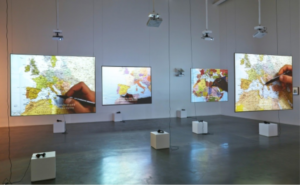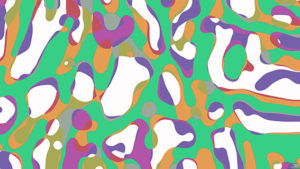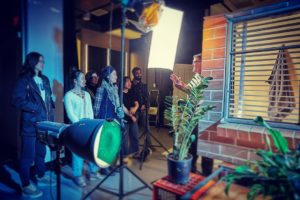Photography Studios: Semester 1, 2020
The BA Photography Studios for Semester 1, 2020 are described below. These are the options for the second and third year students offered under the following course codes:
Photography Studio 2 VART 3595 (2nd year)
Photography Studio 4 VART 3598 (3rd year)
Please read them carefully and decide upon your first, second and third preferences.
Provided you are enrolled in one of these courses, you will be able to nominate your preferences through myTimetable between 28th of January and the 10th of February, 2020.
IMPORTANT – You must not repeat Studios and you must enter three different preferences. Every effort will be made to place you in your first or second preference. Allocations are made on the basis of space available and group balance, with the higher year level being given priority (i.e it is not 'first come, first served').

Bouchra Khalili, The Mapping Journey Project 2008-11
1. The Social Turn: Collingwood Studio
While there is no complete agreement as to what constitutes a meaningful interaction or social engagement, what characterises socially engaged art is its dependence on social [relations] as a factor of its existence. Pablo Helguera, 2011
It is possible to photograph something other than the spectacle of a fire. Jean-Robert Dantou, 2015
How can socially engaged photography attend to the politics of collaboration and representation in a reflexive and productive way?
Creative practitioners are increasingly collaborating with communities and with each other, in response to the excesses of individualism and a desire for social and political connection. This ‘social turn’ in art and photography has renewed conversations about the role of creative practice in the community, the ethics of collaboration, the contexts of production, and the benefits of increased civic participation.
This studio is a critical inquiry into photography’s contribution to public discourse and the different ways in which collaboration can be undertaken with communities, individuals, and organisations. Students will participate in a 12-week residency in Collingwood, where they will develop—through a process of co-conceptualisation—a series of group projects in consultation with community members/partners engaged in community-led initiatives.
Current and previous partners include The Social Studio, The Wellington Centre, The Out For Good Project (in collaboration with the Centre for Innovative Justice), ABC Fact Check, Cultivating Community, The Bendigo Hotel, The Visual Stories workshop (in collaboration with the Centre for Multicultural Youth), Collingwood College, and the Tote Hotel.
Meaningful engagement with community partners will drive the inquiry, and lectures, discussions, workshops, and readings exploring the ‘social turn’ in art and photography will help us develop an ethical framework through which to practice. Evaluation of the work will privilege research, ethics, and quality, in relation to how it aligns with the values of our partners. Project outcomes are not predetermined but rely on consultation and conceptualisation with partners. In previous iterations of this course, outcomes have taken the form of newspapers, documentary films/essays, books, campaigns, public events, and exhibitions.
Further Information: A high level of commitment and initiative is required in addition to a willingness to work with community partners. The studio will take place in Collingwood as part of RMIT’s The Photo Lab—a project space for students, alumni, staff, and community. Students will have access to an individual workspace for the duration of the semester, a community of artists in residence, and printing facilities.
Aims:
- Develop skills in active listening and relational ethics.
- Produce a project in collaboration with community partners.
- Demonstrate an applied critical understanding of the politics of representation and collaborative practices.

Justin Ridler
2. Mode: Challenging Fashion
In recent times the fashion industry has experienced significant shifts across ecological, socio-political, economic and ideological paradigms. Fashion photography requires reimagining in order to contribute to this discourse.
How might fashion photographers more critically engage with the broader ethical questions facing the fashion industry?
Design, sustainability, power, subversion, gender, body, technology, publishing, marketing, extended realities are all issues within the fashion industry that question, provoke and newly negotiate. These recent conversations around ‘fashion’ have been challenging and have invigorated the traditional paradigm with many new possibilities.
Although photography is integral to the fashion industry the images we see rarely challenge. What if fashion photographers re-calibrated and reformed their intention to present ‘fashion’ images that acknowledge the transformative power that the photograph offers.
Aims:
- To interrogate fashion photography through the questioning of current practice.
- Develop a body of work that addresses fashion photography as a contemporary practice, taking into consideration the complex questions that surround the fashion industry.

Jo Cicluna & Vivian Cooper Smith, Point Farewell - Cape Schanck #2, 2014
3. Contemporary Landscape
Whether noble, picturesque, sublime or mundane, the landscape image bears the imprint of its cultural pedigree. It is a selected and constructed text… Deborah Bright, Of Mother Nature and Marlboro Men
What are the ways in which landscape photographs can be made meaningful and relevant?
Landscape photography is more than just an aesthetic experience or beautiful depictions of nature scenes; it is an interpretation of place. In this class, we will contend with what it means to make landscape images today — whether romantic and sublime landscapes, human-altered landscapes, or artistic interventions into the environment. You will engage with the historical development of landscape photography and emerging ideas around what it means to represent nature and place in a contemporary context. Throughout the semester, you will produce photomedia-based work that is informed by an engagement with critical discourses aimed at expanding your understanding and practice of contemporary landscape. Learning activities will include image-based lectures, readings and discussions, presentations, critiques, and fieldwork. Informal and formal reviews of work are central to the course, and a high level of personal engagement and initiative is expected.
**important** this course includes an overnight long weekend field trip (3-4 nights) in the second half of the semester. It is expected that students will arrange their schedules in order to participate. Costs will be kept to an absolute minimum, but it is a self-funded trip.
Aims:
- Develop technical, conceptual, and aesthetic skills for photographing landscape issues.
- Develop a basic understanding of the critical discourse around landscape photography.
- Develop and refine the ability to be self-reflective and critically evaluate landscape images.
- Develop the ability to work collaboratively to research, plan, and execute a group project.

Greg Penn, Totally Unloaded, 2018
4. 21st Century Photography
The digital photo is always ‘retouched’ or processed, in that it depends on an image-processing programme to make it visible. The computer has overtaken the camera in importance, and the lens has become incidental to the capturing of an image. Conventional photography was defined by the notion of the trace produced by visible appearances of reality. Photo-realist systems of digital synthesis have replaced the notion of the trace with a traceless record that vanishes in a spiral of mutations. Joan Fontcuberta, Pandora’s Camera, 2014
What is photography in the 21st century?
Photography has experienced unprecedented change as mediums unravel, merge and collapse into a vast hybrid mesh of possibilities. We are witness to photography’s expansion, connecting with moving image, sound, sculpture, installation, performance, drawing, painting, writing and many other forms. This is an incredible period in which to consider what we mean by ‘photography’. The medium has a rich history of experimentation, from the avant-garde of the1920s to conceptual art of the 1960s through to the 1980s and the rise of new media. Today we are fortunate enough to combine all this knowledge with digital and ever-expanding technological discoveries.
Through a wide variety of explorations and experimentations, students will be able to expand their conceptual possibilities and approaches to photography by considering how new techniques and old traditions merge and align with their own individual practice, connecting and enriching their image-making experience. They will explore unknown territories and absorb valuable insights into what it means to be a photographer today.
Aims:
- Consider what being a photographer means in the 21st Century.
- Position oneself in the dynamic image world as a confident and inquiring image producer.
- Develop skills and expand beyond the conventional definitions that have traditionally framed photography.

Wade Guyton: Das New Yorker Atelier, Abridged. Serpentine Gallery 2017
5. The White Cube
In classical modernist galleries, as in churches, one does not speak in a normal voice; one does not laugh, eat, drink, lie down, or sleep; one does not get ill, go mad, sing, dance, or make love. Indeed, since the white cube promotes the myth that we are there essentially as spiritual beings - the Eye is the Eye of the Soul - we are to be understood as tireless and above the vicissitudes of chance and change. Brian Doherty
What does the space of the white cube do to art work; how is it read as an art object and how can the viewing subject negotiate and read this work?
The White Cube Studio is based on producing a body of work with an economic, social and aesthetic context through a personal, political and a cultural lens. This inquiry will lead to exploring different ways of producing and presenting the photographic image. From the traditional wall-based work in the digital form using pigment printing through to outputting images for other forms and materials that responds to the historical context of the gallery. In this Studio you will cast a glance back at fixed images in caves from the Paleolithic period through to itinerant digital art in a contemporary context presented in a white cube; grounded in a photographic discourse. Your works will be based on a proposition that will unfold through a process driven, self-directed investigation. The project that you produce will consider a spatial strategy as a highly considered aspect of its production and presentation. You will examine how artists develop projects for the highly controlled context of the modernist gallery.
Aims:
- Write a proposal for a gallery saying what, why and how and design an exhibition.
- Engage in critical conversations that examine the material and philosophical qualities of your work in a studio; in process, and in a gallery context.
- Produce work in appropriate materials that reflects on your proposal.
- Write an artist statement which unfolds the particularities of your work.
- Become receptive for the potentials of chance and change in your work.

Bronek Kozka
6. The Working Photographer
Visual ideas combined with technology combined with personal interpretation equals photography. Each must hold its own; if it doesn’t, the thing collapses. Arnold Newman
How does a photographer work collaboratively and professionally to produce images and campaigns that are considered and responsive?
The Working Photographer Studio will function along the lines of a professional commercial photographic studio, serving as an umbrella under which students will work collectively and individually to learn, build and further develop their skills as thinkers, creative photographers and entrepreneurs. Our studio will be a creative hub of investigation and research, where ideas and imagination will drive a creative practice. Students will work with clients, professionals and/or other students in design, advertising, production and marketing.
Students will gain high-end strategic and critical thinking skills informed by the latest research, equipping them with the ability to create powerful, innovative and refined image based solutions to meet the needs of the communication design industry, advertising and other clients.
Students will produce work that is considered and responsive and is the product of communication with clients, research, planning, innovation and collaboration.
Aims:
- Developing and strengthening students photographic skills to create visual interpretations and responses.
- Encourage interdisciplinary teamwork, communication, collaboration, project management and creative problem solving through client interaction.

Clare Rae, Untitled Self Portrait, 2019
7. Performative Photography & the Body
The self portrait photograph then becomes a kind of technology of embodiment and yet one that paradoxically points to our tenuousness and incoherence as living, embodied subjects. Amelia Jones, 2002
How can performative photography complicate notions of identity and subjectivity?
This studio will explore the history of staged and performative photography, surveying a field of practitioners who engage photography to explore performance, the body, identity and sexuality. Throughout the semester we will consider current debates and issues around performance and documentation (the liveness debate and re-mediation), the politics of self-representation, the artist’s body and phenomenology, and the complexities inherent in the photographic process of self-imaging.
Students will initially formulate a question to shape their research, which will then inform the visual outcomes. Through consultation and peer discussion students will propose and develop a photographic project utilising an aspect of performativity or the body to address their research interests. The studio will be delivered through a mix of lectures, tutorials, readings and responses, workshops and critiques.
Aims:
- Introduce students to a range of contemporary artists working in relevant fields.
- Develop a research methodology to inform the production of artwork.
- Develop an understanding and awareness of current discourse and applicable photographic theory and critique.